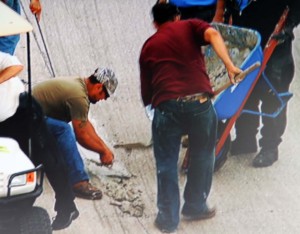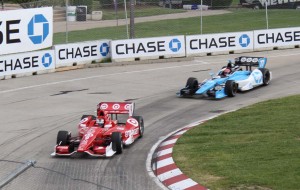Detroit’s weather-beaten roads are a frequent target of criticism, but drivers on the IndyCar circuit were particularly disturbed when the surface on the Motor City’s Belle Isle race track began to break up, leading to a crash and a long delay as crews raced to patch things up.
After a more than two-hour delay, the race was allowed to resume, albeit in abbreviated form, with Scott Dixon delivering the victory in a Target Chip Ganassi Honda, his first win of the year.
The Detroit race was the city’s first since 2008 and was intended to serve as a highlight of Motown’s turnaround, with sponsors including Chevrolet and race and industrial mogul Roger Penske investing heavily to pull out all the promotional stops.
Initially, the biggest problem appeared likely to be the rain clouds that hovered over the Motor City since Friday’s practice sessions began. But by Sunday the weather finally seemed ready to cooperate. Unfortunately, the track didn’t.
After four years’ lack of maintenance, the concrete roadway had developed a number of gashes and grooves that were filled in with asphalt patch. That led to almost immediate complaints about the roughness of the course. But over time the situation worsened. By the time the IndyCars were set to run their high-grip tires began to pull the asphalt up.
“I’ve never seen anything like it before,” said driver James Hinchcliffe, recalling his crash, one of the events that caused race officials to send out the red flag temporarily halting the race.
“Between turn five and turn nine, giant pieces of this tar have been ripped up,” the driver recalled, “and I guess there was nothing they could do about it. It was like playing Russian Roulette and I just pulled the bullet.”
A number of other drivers, including Chevrolet’s Will Power, reported damage to tires, wings and other parts of their vehicles.
“It’s very difficult. I saw pieces coming up,” complained Brazilian driver Helio Castroneves, a three-time winner of the Indianapolis 500.
For his part, Graham Rahal – son of 1986 Indy 500 winner Bobby Rahal – was one of the many IndyCar Series drivers insisting that race organizers “have got to make it safe” before sending cars back out on the track.
The problem, it turns out was not entirely unique. In fact, broken road surfaces have plagued many a racing series in recent years, especially with improvements in tire design yielding so much grip that even seemingly perfect surfaces have ripped up. NASCAR had to halt that action at Daytona a year back and the series has developed a quick-set patch for just such instances.
The question was whether repair crews could cover so much ground at the Belle Isle track before the sun began to set – and whether the patch would dry quickly enough.
Eventually, after an inspection by the race leaders, including Dixon, officials gave the nod, starting out with two laps under the yellow flag. Satisfied the patches would hold, drivers were given the green flag, though there would be another caution before finishing the final 15-lap shootout.
That abbreviated finish meant the race was completed after just 60 laps, not the planned 90. Complicating matters, drivers were not allowed to switch tires before the re-start even though conditions had changed so dramatically.
That was one reason offered why this year’s Indy 500 winner, Dario Franchitti, was only able to muster a second-place finish behind Dixon.
“We have to focus on the positive,” Dixon said after his podium-topping finish, adding that, “I’d like to give a lot of credit to everyone at IndyCar and the Detroit staff for getting the track back in shape so we could finish the race.”


